#juan carlos caballero
Text


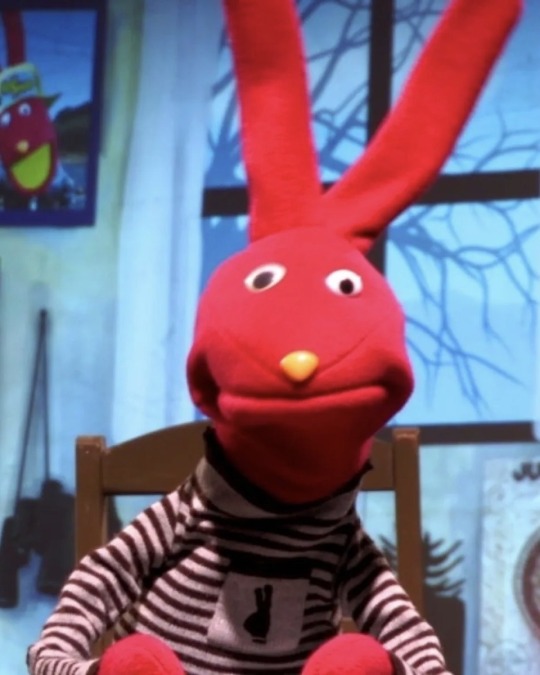
249 notes
·
View notes
Text
"the colombian telenovela starring jorge enrique abello then remake it in mexico but have jaime camil play the male lead" pipeline is so interesting yet funny
#can someone put them in a room please#jorge enrique abello#jaime camil#ysblf#yo soy betty la fea#por ella soy eva#en los tacones de eva#armando mendoza#fernando mendiola#juan carlos caballero mistral#juan camilo caballero#rogelio de la vega
8 notes
·
View notes
Text
Sr. Ávila Season One Analysis
Word Count: 5,971
Warnings: There is a brief mention of necro and n0nc0n and a reference to suic1de, which is part of the plot. This section has a content warning, so you can skip past it!
Ávila season one starts with Roberto Ávila being already in the hitmen field. I will begin from Roberto’s childhood, at least what is known from Season One, and go from there. As a disclaimer, I am also going by what the English subtitles provided by HBO themselves have translated the show as. I know the Spanish dialogue may be slightly different for localization purposes; however, I am going by the English subtitles as I don't speak Spanish. I will post almost all the clips I mention or reference to my Tumblr blog, @Nachocheesevarga, for those interested. With all that out of the way, let's get started. Not much is shared about Roberto’s childhood in the entire series, regardless of season one. Yet here are things known about Roberto.
Roberto’s family is clouded in mystery, and there isn’t enough information given, but what is known is that he has a father and a mother. His mother will be brought up in my discussion on season three, as no information is known of her in season one. Roberto’s father seems to have respiratory issues, which an oxygen tank can see. He is seen smoking a cigarette, so it is to be assumed he most likely had gotten it from a long-time nicotine addiction. His father is also in a wheelchair however, this wasn’t always the case. In episode eleven, titled Freud and Ghosts, we get to see the first glimpse of Roberto’s father. His father is supposedly the one who got Roberto to kill first. This is because a man named Robledo shot his father, which is presumably why he is using a wheelchair and not able-bodied. Roberto claims his first kill was because of his father. His killer had his father's voice and drove him to murder Robledo with a baseball bat. The show later on contradicts this statement but I will get to that when I write my analysis on season three. Roberto claims he killed Robledo because “...he showed me in the worst possible way that my dad wasn’t immortal” (Freud and Ghosts 20:00-23:59). Roberto’s father had already paid for the hit so Roberto had gone to return the money which is how he met Moreira which there offered him a job. Once again the show later on has a different contrasting point on if this is all true, but I will mention that once we cross that bridge. Given that Roberto has been in the hitmen business for 15 years, it is assumed that 15 years ago, he killed Robledo, marking that as when Moreira hired him. Before I move on past Roberto’s biological family, I have to talk about Roberto’s sister. I don’t think this was anything more than a one-liner; however, as I am doing this analysis, it is crucial to mention it. In episode nine, titled The Child and the Spiderweb, there is a brief mention of a sister aspiring from a joke. Roberto and the man who works at the scrap yard speak and have playful banter. After this, he mentions that Roberto needs to tell his sister that he is coming over later. This sister is never once brought up again in the entire four seasons. I am chalking this up to be a one-liner, and since it was so early in the show, they didn’t think much about it. However, as it was mentioned, I had to at least talk about it. Next, I will discuss Roberto’s child Emiliano and his wife Maria.
Roberto and Maria’s meeting is talked about in season two so I will stick to season one only for now. Maria is forty years old confirmed in episode one titled Surprise Party. The episode confirms Maria is forty years old, starting season one. Roberto is confirmed to also be in his forties. While his age isn’t specified, it can be assumed that he is either exactly forty or in his very early forties. I think it’s more plausible that he is also forty, just a couple of months older than Maria. The Priest is who mentions this, stating that Roberto is already forty and should take the job as the Don (A Lousy Job 4:30). Emiliano is confirmed to be seventeen as well in episode six, Reliquaries and Vampires. This means that the youngest, Roberto and Maria had Emiliano when Maria was 23, and Roberto was at least 23, if not a few years older. Maria and Roberto’s marriage date is unknown. However, the day they got married was on August 11th, confirmed in episode thirteen, titled A Child's Gaze. Now, we will look at Roberto’s earlier life.
Roberto joined the hitman agency when he was at least twenty-five. This would make Emiliano two years old when Roberto started working for Moreira. However, Roberto worked as a police officer before his job as a hitman. In Mexico, the age to become a police officer is 18-35. This can mean that Roberto may have joined the police academy as soon as he graduated and left the police around when Emiliano was born or before Emiliano was two. Roberto worked on the police force with a man named Bermudez. Bermudez, in an altercation shown in a flashback, shot Roberto in the hand, leaving Roberto with a scar on one of his hands (A Lousy Job). Roberto, in this same episode, also seems to struggle with PTSD due to these experiences in the police force. He has a flashback while sleeping and can be seen thrashing in his sleep. He wakes up, and his hands end up on Maria’s neck. Maria isn’t freaking out, only worried about Maria, which has the undertone that this is something that has happened a few times, at least to the extent that Maria is not freaked out by what happens. She instantly calms down Maria holds him gently and tells him that it’s alright (A Lousy Job 33:00). This episode also showcases Roberto showing symptoms of a panic attack as well and when he is tasked with killing Bermudez he is visibly shaky and sweating. Roberto, as mentioned, joined the Hitmen agency around the time he was 25. He tells Ybarra that he is broke and doesn’t have a job at the moment and that is why he is joining the agency. Roberto seemed to initially join the agency because he needed money with a very young child to support and a wife (By the Book).
Ybarra, in this same episode, is also revealed to be Emilaino’s Godfather and is also the closest person Roberto had. Episode two, By the Book, has some of the most insightful information about Ybarra. Ybarra has been in the business for over twenty years, meaning he has been in the company five years longer than Roberto has. He was also Roberto’s mentor when he learned the ropes. Ybarra is revealed to have an eye problem, causing him to kill the wrong person. Ybarra claimed to have been all over the city and not a single doctor saw anything wrong with his eye (Surprise Party). This is later on in the series, so for those who are aware of what happens, I firmly believe the apostles had planned this and done something to Ybarra’s vision, which led to the mistake that pushed Roberto to kill Ybarra. Killing Ybarra is the first part in which we see Roberto’s mental health slip. When he is told to kill Ybarra, he fights it. Yet when he goes to the Priest, the Priest eggs Roberto into killing him. He also encourages Roberto to take the role of the Don. This pressure makes Roberto murder Ybarra for the rule he broke. Yet in episode one, Surprise Party, Ivan defends Ybarra’s mistake and tries to reason with Moreira on sparing Ybarra. This causes Moreira to snap at Ivan and remind him why they have rules. This is one of the more exciting points because it gets into the next section, the funeral parlor members.
Ivan was Moreira’s right-hand man. He was working there before both Ybarra and Roberto. Ivan’s relationship with Moreira is fascinating as Moreira was only in the first few episodes. However, it is clear that his death had a massive impact on Ivan. When Ivan finds Moreira’s suicide, he kisses him on the mouth. He is also seen in that episode snorting Moreira’s ashes. Whatever the relationship the two had, it was intense. Ivan becomes much more colder after this. He shows Roberto certain things but is also very reclusive about everything. He cares for the business and clarifies that Roberto is not above that. Roberto may be the Don but he is in no way above the organization. Ivan helps keep things running smoothly. He kills Roberto’s mistress, Maggie, who he is cheating on with Maria. He tortures Emilaino to find out how it will affect the organization. He threatens to put a stop to Maria in case she digs too far and Roberto quickly puts an end to the idea. Ivan is one of the most dangerous characters in the show because he stops at nothing to put the crime organization first. Ana is the mortuary cosmetologist for the funeral home business. She is close with Ivan to some extent. She is reticent in season one. She rarely speaks unless spoken to; when she does, it’s only a few words. Ana is focused on her work and loves to make people remember who they were when they were alive.
Next, I will be talking about Maggie. Maggie is who Roberto sees while he has his double life. Roberto uses sex as a coping mechanism. When things are stressful at work, and he's had a bad day, he can roughly fuck her. She is more of a vessel for Roberto, who can use her for sex when he is too overwhelmed. It’s not entirely clear when the affair started, but for a good part of Roberto’s life, he is faithful. When mentioned about whoring by Ybarra, Roberto quickly dismisses it by saying he has a wife. Roberto at some point, got into a relationship with Maggie. The affair had been going on for at least six months, as six months ago, Roberto gave Maggie the bracelet (Neither Borge’s nor God). This episode means it’s assumed that the moment he gave her the bracelet, the two officially started seeing each other and went from courting to starting their commitment to being friends with benefits. In episode one, it is also confirmed that Maggie is only thirty years old, a decade younger than Roberto and Maria. Roberto uses sex as a coping mechanism, and when Maggie mentions Maria and says she will tell her about their affair, Roberto is hostile. He threatens to hurt Maggie if she dares to touch and interfere with his family life. When Ivan kills Maggie, Roberto is distraught. He seems to show real emotions as benign distraught and calling her dozens of times. In episode six, Reliquaries and Vampires, Maria wants to engage in sex and asks Roberto as she thinks it might help her feel better, yet Roberto is too focused on Maggie’s whereabouts. He says he's too tired from work and leaves Maria alone. Later on in episode seven, titled To Kill an Immortal, Roberto and Maria engage in sex. It’s rough, and it is something he would have done with Maggie. While the sex scene plays out, Roberto imagines it as Maggie instead of Maria. He is rough with Maria, and afterward, Maria mentions they haven’t done anything that rough in ages. Maria and Roberto seemed to have an okay bedroom life. There were two scenes showcasing their bedroom life. It appears that Roberto uses sex as a coping mechanism and uses Maggie as an outlet for his rage. Roberto, later on in the show, continues these unhealthy trends of using sex as a coping mechanism, and it seems to be one of his most exciting vices. While on the topic of vices, Roberto is seen participating in a dog fight and betting on a dog, and while it is only seen in one episode, the act of violently participating and watching a dog getting torn to shreds when Maggie wasn’t available for him to have sex with is a point to mention.
Now, I wanna dwell on Sanchez. Sanchez is one of the most exciting characters in the show because of his fall from grace. In season one he starts as being very competent. He knows what to do and how to poke the hornet's nest. He can piss off Roberto just by simply being there, and he can pin out Emiliano as being a suspect very quickly. He applies pressure to Emiliano and causes Emiliano to mess up his story by mentioning how the girl is probably already dead. He also is the one who leaks Roberto’s affair with Maggie to Maria. He caused a ripple effect, and out of all the people to have caused Roberto to falter, Sanchez is one of the top characters in this category. Sanchez in A Child's Gaze, Sanchez has been bought out and becomes one of Roberto’s lap dogs after Roberto murders his partner on the police force. He is using a man on the inside of the Mexican police force and using it to his advantage. Since Emiliano is mentioned in Sanchez’s section, I wanna focus on Emiliano.
Emiliano is one of the more tragic characters as he longs for his father's approval and doesn’t have the proper guidance. Emilinao is seventeen years old. He seems to be a loner in the earlier episodes before he meets Ismael. He is seen getting made fun of and bullied. He sits alone at lunch. Emilino kicked the dog in episode two, By the Book. This was the first episode in which Emiliano clearly needed support. He needed a crutch of support for his anger issues that stemmed from Roberto. He needed a healthy outlet, but Maria’s own anxiety and fear hindered her from being that crutch Emiliano needed. Roberto is too concerned with Ybarra and the offer of becoming the next Don, which leaves him useless in his son's pleas for help. Emiliano was struggling, and he didn’t get that support. After Emiliano cuts a student's ankle with a box cutter, he is kicked out and forced to go to a rougher “delinquent” high school. This is where he meets Ismael. Yet Emiliano does get a talk from Roberto, which looks pretty heartfelt. He explained to Emiliano that holding in your anger can be dangerous. He also assures his son things will be okay. Roberto, for a split second, was human. Emiliano needed that. Yet Emiliano begins to fall into a darker path. Ismael helps him kill “the Beast” so he can date Juliana. Juliana is only playing with Emiliano, and after some pushback from Ismael, Emiliano murders her with a wooden stake. Content warning for the next section, I will be talking about the fictional rape that happens in this show. There will also be a brief mention of attempted suicide. Be warned and move to the next paragraph to avoid this. Stay safe. Emiliano reveals to Ismael that he raped Juliana after he killed her. This is one of the darkest aspects of the first season. This rape is something so dark that doesn’t have much else attached to it other than Emiliano does show to have remorse. He is seen breaking down when he tells Ismael and sobs into his jacket. I think while what Emiliano did was sickening and terrible, he needed serious help. Maria will be mentioned next, but the way she was of no help to Emiliano, and Roberto is so far away in his hitmen's work they leave Emiliano to drown. While his actions may be irredeemable, it is essential to look at how they stem. Emiliano needed to see an actual therapist and get real help when he was showing violent tendencies, but his mental health was neglected. Later on in the show, Emiliano attempts to kill himself. This isn’t a ploy for attention. Emiliano is in severe mental distress. He was abused and tortured by Ivan while being blindfolded. Maria calls Emiliano a monster like Roberto. He is deemed and cast out by his mother. Roberto isn’t much help either, as he and Maria fight, and it causes even more trauma to Emiliano. Emiliano ends up slitting his wrists, attempting to kill himself. Maria found him staring up at the ceiling, waiting to die. This is one of the heartbreaking moments. Maria accuses Roberto of being the reason and trying to get Emiliano to kill himself. Although Emiliano says, he’s alive because of his father. I take this as Roberto saving Emiliano from prison, which is why he says this. Roberto asks Doctor Montes to look after Emiliano. Doctor Montes explains to Roberto that Emiliano did try to end his life, and he wanted to die. He needed reassurance from his father. Montes mentions that Roberto needs to tuck him into bed, leave a light on, and ensure he knows he is safe. Roberto quickly failed Emiliano out of everyone else in his life. He needed that comfort and to feel protected and he didn’t have that. Emiliano dies not from Ismael but from Ivan. Ivan presses down, snaps Emilianos neck and lies to Roberto. This is the foundation of distrust Ivan and Roberto stand on. Emiliano died tragically and was dragged into this crime of life due to not having a support pillar around him.
Maria is the next person that Roberto fails. I think she has one of the most tragic stories. Maria develops anxiety in episode one. She is overwhelmed, and on the day she turns forty, Roberto has planned a surprise party for her, inviting over their friends. Maria is overcome with fear after having a rough day passes out. When she wakes up, Roberto is next to her, comforting her. His love for Maria seems strong, and he calls her loving names, like a princess, as he prepares her an excellent breakfast. Maria, however becomes more and more unwell in the episodes. In episode two, Roberto asks Maria to walk with him after he sees how stressed she is over Emiliano. The gesture is sweet and caring, but Maria declines his offer. This is the same episode where the two are not cuddling in bed. Roberto lays alone on his side of the bed and curls up alone. It is the beginning of the ending for the two. Roberto does try to reach out to Maria but she persists that she is okay. The most exciting thing is how Roberto shows concern yet never acts on it. He is worried about her. He mentions it to the Priest and Ivan, but he refuses to give any push. Roberto will be gentle with her and ask if she has gone out today, and Maria will say no and say she plans to go out tomorrow. Roberto is concerned but also doesn’t act on that. He is too busy with being the Don, and Maria falls deeper into her depressive episode and is consumed by anxiety about the outside world. What they do in the show is interesting because they use television as Maria’s fixation.
The television isn’t just a source of entertainment but a way for her to still be connected to the world. Maria uses media and the TV as a way for her to get lost away from the real world. Outside of the TV, she has a neglectful husband and a son who is unstable and getting into fights. Inside the TV, she can use it as an escape mechanism and can watch shows that make her laugh or cooking shows. This spirals from her having a panic attack and fainting at her surprise party to not going out for weeks. The television became her connection to other people. Multiple times during multiple episodes, Maria is seen breaking down and crying on the floor, isolated and without her family. They have no food in the pantry or fridge because Maria hasn’t been able to go grocery shopping. When Roberto gives up on trying to get Maria's help, he passively ignores her, with the two facing away from each other. Finally, their television service is shut off due to an issue with the autopayment not working. Maria is without the one thing helping her dissociate from reality. She panics and begins to search through the whole house and finds Roberto’s wad of cash shoved in one of his jackets. Maria ends up leaving the house to pay for the bill in person, but while there, due to the overestimation and anxiety, she breaks down and throws a trash can, attacking the clerk at the desk. That night Maria is quiet as Roberto goes to comfort her after Emilaino leaves to his room. Maria and Roberto begin to argue once she reveals she found the money. Roberto mentions that he had won it gambling on Emiliano’s birthday when he lied and said he was working. This is untrue, something Maria sees as Roberto never gambled and hasn’t in a long time. This is true as Roberto appears to gamble only in one episode throughout the show, and he does so at a dogfight.
Roberto encourages Maria to see Doctor Montes and Maria ends up agreeing. In episode eight, titled God's Whims, it is revealed Maria had seen a therapist in the past due to having postpartum depression when she had Emiliano. When Doctor Montes finally sees Maria, he is working under Roberto, focusing on making Roberto look good. He gaslights Maria into believing Roberto and trusting him again. I think how Maria is revealed to be manipulated over and over again in this show is something so profoundly tragic. When Detective Sanchez arrives to tell Maria about Emiliano’s potential involvement in the murder of Juliana. Sanchez then decides to poke the hornet's nest and reveals the bracelet Roberto gave to Maria was originally for Maggie. This throws Maria into a spiral as she slaps Roberto across the face and locks herself in their bedroom. Roberto tries to reason with her but Maria has no trust in Roberto anymore. He never told Maria about Ybarra’s death, which further puts a wedge in the couple. Roberto is sleeping on the couch, and Maria is deeply hurt.
Maria and Roberto repair their relationship somewhat when Emiliano nearly ends his life. The two reconcile at their house once Emiliano returns home from the hospital. While this should be something sweet, it is cut short when Roberto realizes Ismael is still alive. He requests that Maria go to her sister's house while they sort this out. Maria is hesitant and after a bit of pushback, she reluctantly agrees to go. As Emiliano and Roberto leave, Maria is left alone. As she gets in the car, it is revealed Ismael has been waiting for her. Maria instantly panics and reaches to take her prescribed medicine for her anxiety and panic attacks but isn’t able to. After following Ismael’s instructions, he stabs her with a tranquilizer, paralyzing her body temporarily. She is a limp doll, and Ismael decides to torture her. He first takes her to a food court, where he reveals everything. He tells Maria who Roberto is and how the funeral home is a front for the hitman business. Maria is horrified and can be seen with tears in her eyes as she is faced with the realization that the man she has been married to for over fifteen years has lied to her. Next, Ismael takes Maria to a soccer game. This game is filled with people cheering and hollering, which causes Maria distress. Her anxiety is at an all-time high with the realization that her husband has been hiding his true identity, and with her being in front of a crowd of hundreds, it is her own personal hell. When Ismael leaves to go to the bathroom she makes a break for it. She slowly begins to stumble as best as she can away from Ismael. Onlookers question her stumbling but when she sees Ismael in the corner of her eye, she begins to panic, running into the streets. There, a car accidentally hits her, leaving Maria with amnesia and unable to remember anything. When Roberto gets the call, he gets to the hospital as fast as he can, and when he sees her, Roberto decides to be genuine. He admits to his entire life. It is one of the few times Roberto seems genuine about anything. Yet there it is revealed Maria doesn’t remember who Roberto is. Roberto is distraught and hurt as he curls up with Maria holding her throughout the night.
When Maria can go home Roberto has Doctor Montes help look after her so she can regain back her memory. Maria instantly recognizes Emiliano's photo but cannot piece together who Roberto is. She becomes volatile and smashes a picture frame over Doctor Montes’ head, claiming that she will always be able to recognize her son. The next most significant moment is when Maria discovers Emiliano’s corpse posed as if he hung himself in their garage. Maria is panicked and frantic screaming at Montes and Roberto. Roberto tries to reassure her that Emiliano is sick and he killed himself, but Maria quickly grabs the gun next to her. While it is off-screen, it is revealed Maria shot Roberto and shot Montes in his left arm; thankfully, Montes is right-handed, unlike Roberto. Roberto tells the priest Maria has gone crazy and explains how he murdered Ismael. For this season, that is where Maria is left. She was deemed crazy and unstable, and living in a designated home, the trauma she went through and hurt wiped away as she seems to have a clean slate now. Now, with all these characters and episode-by-episode synopsizes out of the way, I want to talk about Roberto.
Roberto is one of the last characters I have decided to discuss because I have so much to say about him. As mentioned before, at the very beginning, Roberto joined the police academy, most likely right out of high school. Roberto was groomed into becoming a hitman and into becoming a don. I will talk about this more in-depth in seasons three and four, but it is something so important to me. His own father insinuates that Roberto is to kill Robledo. While Roberto does offer first, it doesn’t make sense why Roberto would offer this, assuming this is around the time he just left the police force. I think he does it because he looks up to his father. Roberto’s father isn’t talked about nearly enough, but Roberto claims that was the first time he was ever killed. He murdered someone because of his father, and when Roberto murders Robledo, it is so violent. He somehow got him into the trunk of his car and relentlessly bashes Robledo with a bat. When the camera next shows Roberto, he is soaked in blood, and his hands are shaking as he lights up a cigarette and dissociates. This is highly similar to Emiliano killing Juliana, covered in blood and shaking, dissociating. Roberto wasn’t always this way, and what made him this way was something shrouded in mystery and only seen in small slivers.
Roberto killing Ybarra was the first foundational stone of Roberto losing everything and would be the kickstarting point for him in his long fall from grace and descent into madness. Ybarra was more than a teacher to Roberto this is the man who was Emiliano’s Godfather and close family friend. Maria was allowed to meet and personally know Ybarra. He attended her fortieth surprise birthday party. Ybarra was close to Roberto, and whether or not that was a problem for the organization or not, they wanted to test Roberto to see if he was capable of killing someone he cared about. Roberto doesn’t deal with any trauma or grief he has. This is a recurring thing in the show where if Roberto is stressed or needs an outlet, he turns to sex.
HBO, while not ever being one to shy away from sexual content, makes it abundantly clear that Roberto uses sex as a coping mechanism. When he has to kill Ybarra, and when he does, he instantly turns to Maggie to fuck and have rough sex with. His facial expression isn’t one of love or compassion but one of anger. He uses Maggie. Roberto, in my opinion, never loved Maggie, but he loved what she stood for. Maggie was Roberto’s personal sex doll and was everything his fake life represented. Maggie is the door that stands between who Roberto is and who he pretends to be. He uses Maggie when he needs to release tension from what is happening. She is young, flirty, and cunning, a dangerous combination that Roberto soon realizes. Maggie does have feelings for Roberto. She wants Roberto to skip Maria’s party so the two can have a night together. She disregards Maria as the woman being cheated on and views her as an opponent. If she can’t have Roberto, then neither should Maria. When Maggie goes ‘missing,’ Roberto is increasingly distraught and irritable, and I think it’s because he realizes that what he had for the last six months is gone. The outlet he had for sex and the outlet that was his escape and a personification of his double life is gone. Roberto imagines while he is having sex with Maria that it is Maggie in her place. This sex is rough, and when Maria tries to take off the bracelet that was once Maggie's, he tells Maria to keep it on. He wants Maria to be just for a night, that same personification that Maggie was. A way for him to relieve his stress. Roberto and Maria’s sex life is something dying. When Maria implies that a night of love with Roberto might make her feel better, he instantly brushes it off because he is concerned about Maggie. He jeopardizes their sex life for Maggie. Roberto does love Maria but he is also a hypocrite.
Roberto and Maria have an interesting dynamic because Roberto will say some of the most breathtaking, heartwarming comments about her, and yet he still cheats. I am very biased as Maria is one of my favorite characters in the show so the way I feel so strongly about how poorly she is treated. Roberto refuses to do good pushback with Maria. He is so clearly concerned about her when she faints and, in the next scene, brings her a beautiful tray of fruits from the party and he calls her princess. He does love her. Yet when Maria refuses to see a doctor, Roberto doesn’t have much else to say and leaves Maria to deal with it on her own. Roberto gets so hyperfocused and swept up in the new position as a don, one he isn’t even sure he wants to take, that he shuts out Emiliano and Maria.
Roberto says, “And if something were to happen to her, anything, I would burn the world to the ground” (That Day). When Ivan pushes the idea of needing to take care of Maria if she becomes a problem Roberto instantly shuts it down, and he does multiple other times. Roberto loves Maria, but he is so focused on the double life he is living that he hurts and lies to Maria. He has lied to Maria for fifteen years and started cheating at least six months ago. Roberto is also distraught that killing can be an inherited trait. He talks about this multiple times with the Priest, and the Priest instantly shuts down the idea. Roberto treats the Priest's words very highly. He acts as a venting system for Roberto and it is something deeply personal to Roberto to have this outlet. Maria even mentioned that Roberto started sounding like the pope with optimism when she finally left the house. The Priest is someone intertwined with Roberto, and I wanna say more, but that gets into other seasons’ territories. However, when Roberto shares the most intimate details of his life, it is always with the Priest.
Roberto also has an interesting dynamic with Emiliano. Emiliano’s death leaves Roberto forever changed, and when he sees his son is dead, he is clearly pained. He doesn’t blame Ivan or Ana for what has happened. He is quiet, and I think it is another structure to Roberto that is being torn down. His son was taken away from him by who he thought was Ismael. Roberto trusts Ivan and has no clue about the horrors and lengths that Ivan will go through to keep the business running.
Roberto’s trauma isn’t something dwelled on much in the show, but it is a leading cause of his downfall and his spiral into insanity. He struggles with PTSD flashbacks from being shot in his right hand by his police partner. In a few months, Roberto loses his best friend, son, and the life he once knew. His wife no longer recognizes who he is and is deemed crazy after she shoots Roberto and Montes. He is alienated, and now all he has is the organization, as revealed, Ismael placed multiple hits on Roberto. I think this is clearly where we, as the audience, see that Roberto’s mental health is slipping. He isn’t sleeping much, and the role of the Don is taking a toll on him. Now, he has to face this new chapter of his life without his wife or his son.
Now, the last thing I want to do is quickly go through facts about characters that are known in the show:
Maria is 40
Roberto is at least 40, revealed by the Priest
Maria likes to garden and has roses she takes care of. There are also plants all over the Ávila household.
Roberto likes to do puzzles and has a shed in the backyard where he does them.
In the Ávila household, on their fridge, there is a Pumbaa magnet from the movie The Lion King, confirming that the movie exists in the world and Emiliano liked it as a kid or someone in the family did enough for there to be a magnet of him on the fridge.
Emiliano plays the guitar and claims Roberto isn’t supportive of him.
Emiliano is 17.
Ismael is 18.
Roberto has a scar on his right hand from getting shot by his old police partner.
Roberto was a former police officer
Roberto likes ice cream
Ivan likes ice cream, and his favorite flavor is Rum Raisin
Maria had postpartum depression after she gave birth to Emiliano
Ybarra is Emiliano’s Godfather
Brad Pitt canonically exists in the universe
The show starts in Spring
Ismael and Maria both have birthdays in the spring
Roberto and Maria were married on August 11th.
Ana’s phone is orange, Ivan’s red, and Roberto’s silver.
Maria has a sister
Maria’s sister is named Alice.
Emiliano doesn’t remember what Alice looks like.
Roberto makes Maria special sandwiches after sex.
The main ingredient of the sandwiches is butter.
Ismael was 4 when Roberto killed his father/
Roberto doesn’t like “shrinks” and is very hostile to the concept of seeing a therapist.
Roberto smokes weed and cigarettes
Emiliano smokes weed and cigarettes
Roberto's father was shot in the leg and is no longer able-bodied.
Roberto and Maggie started their affair at least 6 months ago.
Ivan has insomnia
Roberto never talks to strangers
Roberto doesn't have any social media
Facebook is a canon social media in the universe
Roberto suffers from PTSD from being in the police force.
Maggie is 30
#sr avila#sr. ávila#roberto avila#lalo salamanca#sr ávila#roberto ávila#tony dalton#sr. avila#maria avila#nailea norvind#carlos aragon#Iván Alcázar#Camila Selser#Ana Solares#Detective Sánchez#Emiliano Avila#character analysis#in-depth character analysis#character study#Juan Carlos Remolina#Jorge Caballero#Ismael Rueda#eduardo lalo salamanca#avila#ávila
4 notes
·
View notes
Text
Estoy en mi 31 minutos phase: Ahora en Tumblr y el hecho de que Tulio y Bodoque le ganaron al mismísimo José Carioca en dos concursos diferentes, pero que juntos no le pudieran ganar a Cuphead y Mugman es inaceptable. Osea ya sé que José está olvidado hasta por Disney, pero es que la gente ya no entiende sus prioridades. (la gente también soy yo).
#31 minutos#josé Carioca#the three caballeros#los tres caballeros#juan carlos bodoque#tulio triviño#cuphead#my posts
2 notes
·
View notes
Text
El amor de una madre es tan fuerte que nunca te hará perder la esperanza en la vida… “El Amor No Tiene Receta”
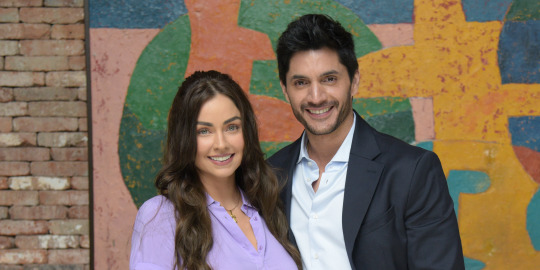
La historia sigue a Paz, una mujer humilde que, tras sufrir el robo de su recién nacida seis años atrás, el destino le da un giro al aceptar trabajar para Esteban, un viudo con tres hijos. Paz se sumerge en una serie de experiencias que la llevan a reencontrarse con su hija y la mujer que le arrebató el sueño de ser madre. En este proceso, Paz comprende que aún puede ser madre y amar de nuevo.
Estreno: 19 de febrero de 2024 a las 8:30 pm por Las Estrellas y en ViX.
youtube
La novela, producida por Juan Osorio, cuenta con las actuaciones de Claudia Martín, Daniel Elbittar, Altaír Jarabo, Azela Robinson, Beatriz Moreno, Antonia Mayer Camil, Isabella Tena, Regina Villaverde, Liz Gallardo, Luz Ramos, Nacho Ortiz, Juan Carlos Barreto, Jaime Maqueo, Harry Geithner, Máxima Nevárez Erives, Hugo Catalán, Emilio Caballero, Sabrina Seara, Andrés Vázquez, Jaime Maqueo y Nicola Porcella.

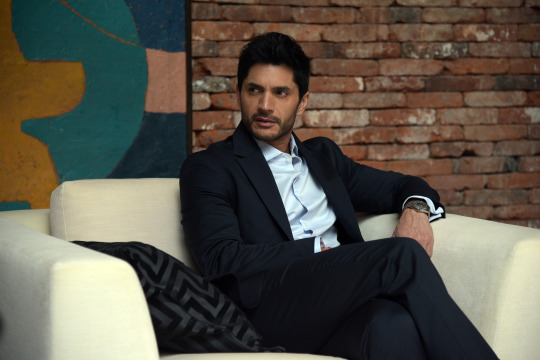

#El Amor No Tiene Receta#Claudia Martín#Daniel Elbittar#Altaír Jarabo#Azela Robinson#Beatriz Moreno#Antonia Mayer Camil#Isabella Tena#Regina Villaverde#Liz Gallardo#Luz Ramos#Nacho Ortiz#Juan Carlos Barreto#Jaime Maqueo#Harry Geithner#Máxima Nevárez Erives#Hugo Catalán#Emilio Caballero#Sabrina Seara#Andrés Vázquez#Nicola Porcella#Novelas#Las Estrellas#ViX
0 notes
Text

Bienvenidos a un torneo mal hecho, poco serio, casi inentendible que incluye: una enorme cantidad de personajes de procedencia dudosa, muchisimas encuestas y una final que va a incluir 3 personajes porque SOY TAN MALO EN MATEMÁTICAS QUE NO CALCULE NADA
AH Y SORPRESA! Metí algunos personajes más creyendo que resolvería el error matemático (no lo hizo)
anyways comenzamos con la primera ronda: Iré colocando acá bajo los links de las encuestas (si me acuerdo JAJSJSJS)
EDIT: Gustavo Fring reemplaza a Namor
Yaolt es reemplazado por Aldeberan de Caballeros del Zodiaco
Primera Ronda
Guillermo de la Cruz vs Coco
Lucas Amato vs El Profesor Jirafales
Dr Flug vs El Mandalorian
Carlos vs Panchito Pistoles
Tulio Triviño vs El Chapulín Colorado
El canario de la película de Rio (2011) vs Rodolfo Rivera
Goku vs El condorito
Lobo/La muerte vs Joaquín
José Carioca vs Isidoro Cañones
Lúcio vs Bruno
Carlitox vs Juandisimo
Lalo vs Compayito
Julio vs Kronk
El papa de Mafalda vs Ravenna
Adrián Seidelman vs Colgate 360
Roberto da Costa vs Don Ramón
Don Armando vs Pacha
Homero/Gomez Addams vs Juan Carlos Bodoque
Héctor vs Mr Trance
Black Hat vs Gabriel Reyes
Locutor/The Host vs Manolo
Guillermo de la Cruz vs Coco
Lucas Amato vs El Profesor Jirafales
Carlos vs Panchito Pistoles
Tulio Triviño vs El Chapulín Colorado
El canario de la película de Rio (2011) vs Rodolfo Rivera
Goku vs El condorito
Lobo/La muerte vs Joaquín
José Carioca vs Isidoro Cañones
Lúcio vs Bruno
Carlitox vs Juandisimo
Lalo vs Compayito
Julio vs Kronk
El papa de Mafalda vs Ravenna
Adrián Seidelman vs Colgate 360
Roberto da Costa vs Don Ramón
Don Armando vs Pacha
Homero/Gomez Addams vs Juan Carlos Bodoque
Héctor vs Mr Trance
Black Hat vs Gabriel Reyes
Locutor/The Host vs Manolo
Gus vs Adelbarán
Doctor Simi vs Santos
Yasutora Sado/Chad vs Albertano
784 notes
·
View notes
Text

TÍTULO: Crucifixión con la Virgen y San Juan Evangelista
AUTOR: Carlo Crivelli
FECHA: 1488-1490
MATERIAL Y TÉCNICA: Óleo y temple sobre tabla
TÉCNICA DE TRABAJO: Temple y óleo sobre tabla
DIMENSIONES: 218x75 cm
INVENTARIO: 197
El políptico fue desmembrado tras los graves daños sufridos durante el terremoto de 1799, que también dañó gravemente la Catedral de Santa María la Mayor de Camerino. En Brera convergían el compartimento central que representa a la Madonna della Candeletta, la Crucifixión con la Virgen y San Juan, así como el panel derecho del registro medio, con los Santos Jerónimo y Agustín; este último se vendió luego a la Gallerie dell'Accademia de Venecia, donde todavía se encuentra hoy. En 1830, un afortunado descubrimiento entre las ruinas de la catedral permitió identificar el panel fragmentario con los santos Pedro y Pablo, destinado también a la Galería de la Academia de Venecia. La cronología del políptico está asegurada por la inscripción: aquí Crivelli se declara "eques", caballero, y este título le fue conferido en 1490 por Fernando, príncipe de Capua.
El Crucifijo llorado por María y Juan es en este caso una imagen que, al mismo tiempo, cuenta un hecho y explica su valor profundo. El pintor representó cuidadosamente el lugar, reduciendo el espacio, y creó la parte superior sobre un fondo abstracto de oro, aludiendo así a la naturaleza divina de Cristo y al papel salvífico de sus sufrimientos, aclarados por el sol y la luna que recuerdan el final. de días como se cuenta en la Biblia.
Información e imagen de la Pinacoteca de Brera.
2 notes
·
View notes
Text












La historia de Valerie Domínguez
Fue señorita Colombia y estuvo entre las diez finalistas de Miss Universo. Se convirtió en actriz y sobrevivió a un capítulo de maltrato físico y escándalos legales. Esta es su historia.
Entrevista con Valerie Domínguez
Foto:
Vikingo
Por: Revista Don Juan 09 de octubre 2018 , 02:02 p. m.
Miss Universo 2006 se llevó a cabo en Los Ángeles, la ciudad de los sueños, la misma ciudad de la que acaba de regresar después de casi una década de trabajo: “Hace unos años mis papás fueron a verme. Mi papá tenía unas ganas terribles de hacer un viaje en una casa rodante y fui con ellos y una amiga. Vimos unos amaneceres espectaculares, medité, sentí que el peso de las cosas malas que tenía adentro se desplazaba y luego se iba. Mi papá se reía, pero al final, debajo de un árbol, me decía: ‘Enséñame a meditar’”.
Meditar y hacer ejercicio la salvaron. Durante el momento más complicado de su vida –el escándalo de Agro Ingreso Seguro– fue a ver a un terapeuta y le recomendaron tomar antidepresivos; se negó de tajo y se refugió en el deporte: todos los días a las 4:30 de la mañana su entrenador personal, Carlos Páramo, se plantaba en la puerta de su edificio con la mejor energía para salir a trotar y animarla para que ella luego saliera a enfrentar el día. Tenía la presión mediática y las peleas con su novio de casi cuatro años, Juan Manuel Dávila, que en ese momento fue procesado y luego condenado por el caso de Agro Ingreso Seguro; también las reuniones con su abogado, el ex ministro de justicia Yesid Reyes, y las grabaciones de Los caballeros las prefieren brutas.
¿Cómo empezó su carrera como actriz?
Nunca soñé con ser reina, pero cuando era chiquita mi mamá me preguntaba: “¿Qué quieres ser cuando grande?” Yo le decía “actora”, y ella me corregía: “actriz, actriz”. Pero en la adolescencia fui cambiando de profesión: diseñé la biblioteca del colegio, hice obras de teatro... Mi papá me pedía que lo acompañara a las ferias de joyería de Suiza, Italia y Estados Unidos. Yo inicialmente no quería estudiar diseño de joyas porque me encantaba hacerlo sin que fuera una obligación, pero mi papá decía que era el negocio que había mantenido muchos años a la familia y yo debía conocerlo mejor.
Después de Milán, me mudé a Florencia a estudiar joyería en Alchimia Contemporary Jewellery School. Mi mamá viajó para mi grado y me ayudó a mudar. Nos fuimos en tren. Estudié tres años ahí y a mi regreso abrí joyerías WAO. Todavía tengo mi negocio de joyería en Barranquilla, pero terminé de reina por casualidad y después del reinado decidí quedarme en Colombia. Fue una gran experiencia y una linda oportunidad poder representar a mi país y viajar por Colombia apoyando obras sociales, me llamaron varios representantes hasta que un día conocí a Gloria de la Pava. Ella fue mi primera mánager, nos sentamos a comer y nos llevamos superbién desde el primer día. Raimundo Angulo me llamó para decirme que me querían en Bailando por un sueño. Fui y bailé. Después me enteré que me querían en Factor X como participante; les dije que no cantaba, pero como era para una causa social me metí de una y casi llego a la final.
Entonces estalló el escándalo.
¿Por qué?
Las pruebas salieron al año y no fue fácil. Todo salió a la luz en el juzgado, incluso el maltrato del que fui víctima. Para uno es un tema difícil como mujer: todas hemos crecido en una sociedad muy machista. Hay algo más fuerte que el maltrato físico y es el maltrato psicológico. Solo ahora que estoy en Colombia de nuevo siento que volví a ser la que era antes. Tuve un break en mi vida, un paréntesis. Yo no sabía lo mal que estaba hasta que, con la distancia, me di cuenta. Yo no veía que estuviera tan mal y salir de ahí me tomó tiempo. Me encantaría que las mujeres entendieran esto cuando conocen a alguien: cuando tú sales con una persona, al principio solo ves lo que quieres ver. Tú, a tu pareja, le cuentas todo: tus inseguridades, tus miedos; te abres. Esa persona decide si te apoya para ser cada día mejor, o si usa toda esa información para hacer lo que quiera cuando quiera. Pero yo solo entendí eso después. Tuve momentos en los que no me reconocía. En la relación todo fue increíble al principio, al mes y medio de conocernos él me propuso matrimonio y luego nos fuimos a vivir juntos. Fue como un matrimonio. Nunca puse fecha para la boda porque tenía mucho trabajo.
¿En qué momento se dio cuenta de que todo estaba mal con su novio?
¿Cuales son esas banderas rojas?
Celos extremos, peleas sin sentido... Soy actriz y en mi trabajo hay todo tipo de escenas, pero tener escenas íntimas era un problema. Llegar tarde de las grabaciones, de las fotos de portadas de revistas, o de lo que fuera. Llegaba al otro día con los ojos hinchados y no dormía nada, las peleas duraban hasta las tres de la mañana.
¿Qué le dijo su abogado?
¿Qué fue lo primero que hizo cuando se fue de Colombia?
Cuando llegué me salió una película de entrada: El poder de la cruz . Ahí trabajé con Sean Astin y Mira Sorvino y grabé una buena cantidad de comerciales nacionales. Hace un año estuve muy cerca de protagonizar una serie de acción para la cadena ABC. ¡Era el papel de mis sueños! Después de pasar varias audiciones y tests , finalmente firmé con el canal, pero desafortunadamente el episodio piloto no avanzó.
Hace un rato hablaba de la meditación y el ejercicio, ¿por qué son tan importantes?
Cuál ha sido un momento memorable?
Mi abuelo nació en Nueva York y le encantaba viajar. Siempre soñaba con los paseos de casas rodantes y mi papá también. Hace dos años mi papá y mi mamá llegaron a Los Ángeles y alquilaron una casa rodante. ¡Estaba muy emocionada! Arrancamos desde Los Ángeles y llegamos a San Francisco pasando por Yosemitee, Sequoia... Nos parqueábamos en los parques especializados para estos carros a pasar la noche. Los amaneceres en cada lugar fueron increíbles y las noches eran llenas de estrellas.
¿Se va a quedar en Colomba?
Por ahora sí. Llegué a hacer una producción con Canal Caracol. Por primera vez, un antagónico. Es la vida del Gran Martín Elías, el hijo de Diomedes. Los vallenatos que más me gustan son los de él. Yo vine en agosto para el cumpleaños de mi mamá y pasé por Bogotá un día. Ese día me llamaron para presentar la audición y cuando regresé a Los Ángeles, una semana después, me preguntaron si quería irme para Colombia. Sin pensarlo dije: ¡De una!
¿Tiene otros proyectos?
Llevo haciendo uno hace más de un año. Hay socios y escritores a bordo. Ya estamos muy adelantados e iniciando reuniones en Estados Unidos. Ha sido un proceso muy interesante, sobre todo porque por primera vez estoy del otro lado, produciendo.
2 notes
·
View notes
Text

'이게 짱이다(=Este Es el Rey)'라는 땅고곡은 두 가지 면에서 조금 미스터리하다. 우선 작곡자가 마누엘 까바예로(Manuel Caballero)로 돼 있는데 todotango는 물론 구글 검색해 봐도 이 인물에 관한 아무런 정보가 없다.
그리고 땅고 황금기 음악이 아니다. tango.info를 찾아보면 후안 다리엔쏘 악단이 1971년에 첫 녹음한 거로 나온다.
또한 todotango와 달리 tango.info에는 까바예로 외에 까를로스 라싸리(Carlos Lázzari)와 후안 뽈리또(Juan Polito)가 공동 작업한 거로 나온다.
라싸리는 다리엔쏘 소속 반도네온 연주자로 2008년 개봉한 다큐 '부에노스 아이레스 탱고카페'에도 출연한 바 있다.
뽈리또는 다리엔쏘가 로돌포 비아지(Rodolfo Biagi)를 시기 질투해 해고한 후 후임으로 고용한 피아니스트다.
까바예로란 인물은 여전히 오리무중이지만, 최초 녹음 시기가 1971년인 이유는 '탱고 스토리 : 우리를 춤추게 한 위대한 악단들' 199쪽에 나온다. 알젠틴에서 땅고 인기가 시들해지자 해외에 팔아먹고자 음반사에서 'Tango for Export'란 시리즈를 기획, 발매했기 때문. 다리엔쏘 뿐만 아니라 아니발 뜨로일로도 같은 시리즈로 음반을 발매했다. 스테레오 발명 이후 녹음인 탓에 당연히 음질이 매우 좋다.
짐작건대 '이게 짱이다'는 수록곡에 옛날 거만 있으면 진부할 수 있으니 신곡도 넣으라는 요구를 받고 악단 멤버들끼리 머리를 맞대 만든 게 아닐까 추정해 봄.
youtube
youtube
2 notes
·
View notes
Text
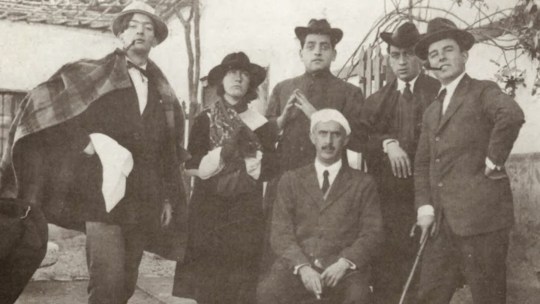
A century of the Order of thuggish and drunken knights: Lorca, Dalí and Buñuel partying in Toledo
Federico García Lorca was wrapped in a sheet stolen from the Posada de la Sangre – which disappeared in the Civil War and was the scene of Miguel de Cervantes's The Illustrious Mop –, drunk as a thief and with the desire to wander alone through the narrow streets of the old town of Toledo. Around him, some young hooligans laughed with the poet with noise and hubbub. This is how a Toledo man named Eduardo met the playwright from Granada during a Toledo night in the 1920s. At that moment, this kind man, seeing the panorama, tried to take Lorca to the relief house on Barco Street, but He flatly refused to accompany him. The poor man, of course, did not understand anything.
What this Toledoan, grandfather of the author of the space Toledo Olvidado, who is the one who told this anecdote, did not know is that Lorca was complying with one of the strict rules of the well-known Order of Toledo, a brotherhood of artists and writers related to the Generation of '27 and the Madrid Student Residence created by Luis Buñuel – calling himself Condestable – in the Venta de Aires de Toledo restaurant in March 1923.
This is how a century ago the streets of Toledo could not believe what was happening on its cobblestones. One hundred years since Buñuel, with his idea, managed to revolutionize the students of the Residence and the silent alleys of the old town of Toledo. Despite such famous components, the truth is that little or very little is known about this Order of Toledo. There is not much documentation available, beyond the stories of the protagonists themselves. Buñuel, the architect of this mischievous and intellectual action, dedicates an entire chapter to the Order in My Last Sigh, his autobiography written in his exile in Mexico.
A religious revelation and the smell of wine
«I am walking through the cloister of the cathedral, completely drunk, when, suddenly, I hear thousands of birds singing and something tells me that I must immediately enter the Carmelites, not to become a friar, but to steal the convent's treasury. The doorman opens the door for me and a friar comes. I tell him about my sudden and fervent desire to become a Carmelite. He, who has undoubtedly noticed the smell of wine, walks me to the door. The next day I made the decision to found the Order of Toledo," explains Buñuel in the aforementioned autobiography.
The rules of the Order of Toledo are strict and taken very seriously by its members. So much so that some of them even had a little problem or another in 1936, as the poet José Moreno Villa told us from Mexico, after the outbreak of the Spanish Civil War. "This order is a bit communist," thought some "men alien to letters and much more alien to irony"; although the truth is that there was only a hint of provocation in this crazy association. A normal thing among extravagant artists, somewhat dadaist, somewhat surrealist. «The starting point was to have fun, have a good time and get drunk. But it is true that, personally, I have always related what these young people did in Toledo with the historical avant-garde of the moment. I see it as the performances that the Dadaists did in Paris and Zurich, which were things that didn't make much sense, as Surrealism later adopted. In fact, it is worth noting that some members of this Order of Toledo were part of the Paris surrealist group, like Buñuel or Dalí himself,” explains Juan Carlos Pantoja, author of The Order of Toledo: imaginary avant-garde walks*.
Pantoja also details that, possibly, there were some precedents to Buñuel's Order of Toledo because "there was already a group of great intellectuals, among whom were Américo Castro, Alfonso Reyes, Antonio García Solalinde or Moreno Villa, who met in Toledo to walk at night and drink wine from 1917 onwards. He details that "they stayed in a rented house on Cárcel del Vicario street, in front of the Cathedral, and they became known as the gathering of El Ventanillo, due to the existence of a small window with views of the Valley. Buñuel says that he got to know Toledo accompanying Solalinde, so we can think that perhaps the Aragonese was at some point in these gatherings and that, from there, the idea of doing something similar arose.
Pepín Bello – who left no work, but was a friend to everyone, as gallery owner Guillermo de Osma once commented –, Rafael Alberti, Dalí, María Teresa León and Federico García Lorca and his brother, among others, were part of the Brotherhood created by way improvised by Buñuel that had something of a "poetic act", according to the poet from Cádiz. And the students of the Residence were lovers of Toledo, according to Bello in an interview in 2000:« We took the train from Madrid to Toledo, we traveled in third class and it took us two hours to arrive. We went up from the station and went to drink in the taverns of Zocodover, which was very close to the Posada de la Sangre, to get into the mood a little »
Order of Toledo: drink wine and do not shower
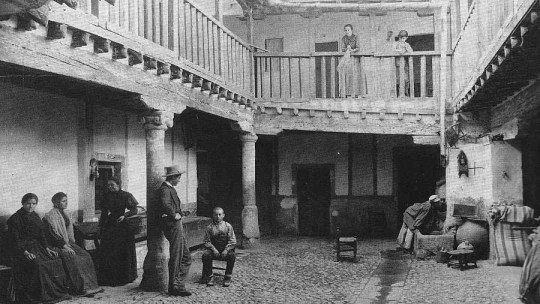
Courtyard of the Blood Inn
Among the rules of the Order of Toledo, and which Buñuel said with his Calanda crudeness, was that of not washing or showering "while the visit in this Holy City lasted." They had to go to Toledo once a year, watch over Cardinal Tavera's tomb, love Toledo above all and, of course, "wander, especially at night, through the wonderful and magical city of the Tagus," according to Alberti. "Those who preferred to go to bed early could not qualify for the rank of knight, little more than the title of squire," explains Buñuel in his autobiography. Furthermore, Pantoja details, "each of the members had to contribute ten pesetas to the common fund for accommodation and food and to go to Toledo as frequently as possible and put themselves in a position to live the most unforgettable experiences." Bello points out, recalling Toledo's adventures in an interview, that "we stayed at the Posada de la Sangre because we were students and it was difficult for us to sleep for just one peseta. Of course, it was a place of dubious cleanliness, where mainly muleteers stopped with their animals. The poet María Teresa León, in her book Memory of Melancholy, also remembered that this inn “had little rooms with just one bed. There, Rafael [Alberti], that night we didn't talk about El Greco, but we did talk about bedbugs. Toledo bedbugs! Toledoan night! I turned on the light. How well Rafael slept with his chest crossed by hundreds of little animals frantically searching for the hiding place of poetry!
Alberti precisely explains in The Lost Grove that "the brothers left the inn when the cathedral clock struck one, a time when all of Toledo seems to narrow, become even more complicated in its ghostly and silent labyrinth" and also relates in detail how He experienced firsthand his initiation into the Order of Toledo, with some fear at not knowing anything about the labyrinthine streets of Toledo.
«We went out into the street, carrying all the brothers, except me, hidden under the jacket, the sleeping sheets, taken out quietly. The poetic act was going to consist of bringing to life an entire theory of ghosts in the atrium and plaza of Santo Domingo el Real. After weaving and unweaving steps between the deep crevices of sleeping Toledo, we ended up at the convent at a moment when its defended windows lit up, filling them with veiled songs and monkish prayers. While the monotonous prayers went on, the brothers, who had left me alone at one end of the square, covered themselves with the sheets, seeming slow and distanced, white and real ghosts from another time. The suggestion and fear that I began to feel were increasing, when suddenly, the dressed visions appeared, shouting at me: 'This way, this way!', sinking into the narrow alleys, leaving me - one of the worst tests I have ever faced. the novices were subjected – abandoned, alone, lost in that frightening winding of Toledo, without knowing where I was and without the possibility of someone showing me the way to the inn, in addition to not finding a single passerby at that point in the night, in Toledo, if they don't inform someone every 30 meters, you can consider yourself lost definitively. At dawn I found the Posada de la Sangre, and I went to sleep, happy with my first adventure as an initiate into the mysteries of the Toledo order,” Alberti recalled years later.
Food and comedy at Venta de Aires
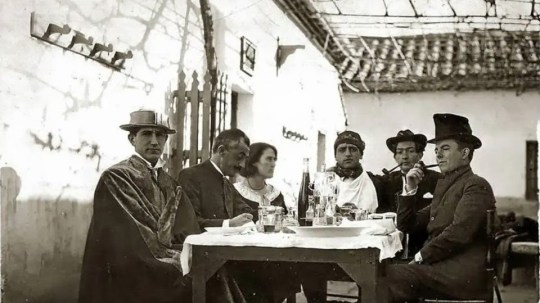
Members of the Order of Toledo, at the Venta de Aires
In Toledo, the members of this order ate, explains Buñuel, "almost always in taverns, such as Venta de Aires, on the outskirts, where we always ordered tortilla on horseback - with pork -, a partridge and white wine from Yepes." . There, in this sale, the friends performed for the first time Don Juan Tenorio, by José Zorrilla, dressed in improvised costumes, where we see that Buñuel is dressed as a parish priest, an irreverence with respect to the church and the double standards of its members that We will always see them reflected in their films. «With regard to this, this relationship between artists and religion, Max Aub told the anecdote that while walking through Toledo they found a Virgin in a niche on the street, it could be the one still located on Alfileritos Street, although it is not documented, that Dalí began to pray in a devout and tender manner, but suddenly began spitting at her angrily and insulting her. He went from one thing to another in an incomprehensible way, once again showing off his surrealist thinking," explains Pantoja.
Alberti says that also on the walls of the Venta de Aires, the brothers of the Order had left the mark of their art. «Under the arbor, the patio of our banquet, the main brothers were portrayed in pencil on the whitewash of the wall. Its author, Salvador Dalí, was also among them. Someone told the innkeepers not to whitewash them, that they were worthy works by a famous painter and that they were worth a lot of money. Despite the warning, years later they no longer existed. They had been erased by new owners of the sale," explains the poet. After eating, they returned to Zocodover, always on foot, making "an obligatory stop at the tomb of Cardinal Tavera, sculpted by Berruguete. A few minutes of contemplation in front of the recumbent statue of the cardinal, dead of alabaster, with pale and sunken cheeks, captured by the sculptor one or two hours before the putrefaction began," adds the filmmaker.
Fisticuffs with the cadets of the Military Academy
Upon returning to the old town, the Order even experienced some fights with the cadets of the Toledo Military Infantry Academy, after some of them rudely complimented María Teresa León, an anecdote that she herself tells. «At I don't know what time, just when we were visiting some taverns to balance with so much church, we came face to face with a group of uniformed boys, who turned to me and said: 'Blonde, I would eat you with suit and with everything'. Buñuel rolled up the sleeves of his shirt and when he saw him advance, the boys ran out so as not to commit themselves to Aragon, a region where the insults are harsher. They caught up with them and, after several punches, the cadets were defeated. A neighbor handed us a jug: 'Drink, drink. These cadets always making a fuss!' Meanwhile, she licked her lips with pleasure because the civilians had beaten the military, those boys are always on the hunt for Toledoan girls," León said.

Rafael Alberti and María Teresa León, poets of the Generation of '27 and members of the Order of Toledo
A confrontation with the military that Buñuel also remembers, although in a somewhat less refined way than the poet. The film director explains in his memoirs. «The cadets were really scary. One day we came across two of them and grabbing María Teresa, Alberti's wife, by the arm, they told her: 'How horny you are.' She protests, offended, I go to her defense and knock down the cadets with my fists. Pierre Unik comes to my aid and kicks one of them. There were seven of us and the two of them, we did not boast. We leave and two civil guards who had seen the fight from afar approach, instead of reprimanding us, they advise us to leave Toledo as soon as possible, to avoid the revenge of the cadets. We don't pay attention to them, and for once, nothing happens».
The Order of Toledo in Tristana
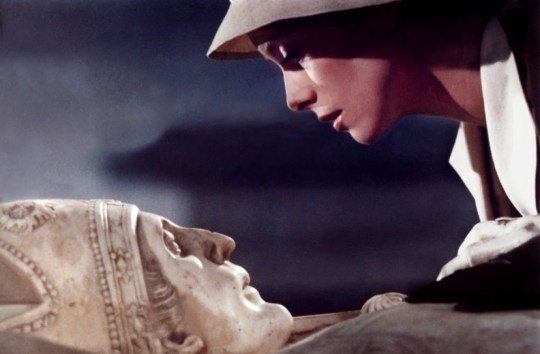
This entire Order of Toledo is reflected in Tristana, the film that Buñuel would shoot here in Toledo. Pantoja defends that "he winked at his youthful adventures, with Catherine Deneuve wandering the streets and visiting Cardinal Tavera, and bringing his face closer to him, which is one of the great images of the film." «That Order of Toledo laughed at everything, nothing was taken too seriously. They laughed at art, like the futurists did, who advocated burning museums and libraries, and they did everything, in addition, in a groundbreaking way. Their lives, without a doubt, were pure avant-garde," concludes Pantoja.
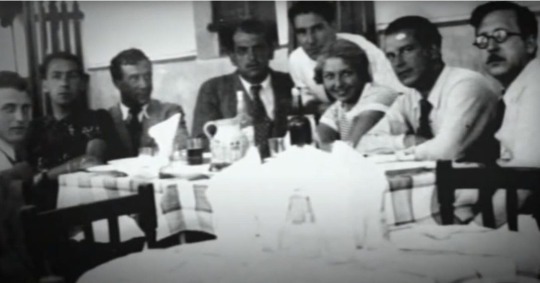
* I have scans of this book, I am planning to publish them here on Tumblr on a series of posts
#la orden de toledo#caballeros de la orden de toledo#knights of the order of toledo#federico garcía lorca#luis buñuel#salvador dalí#order of toledo#maría teresa león#rafael alberti#pepín bello#josé moreno villa
1 note
·
View note
Text
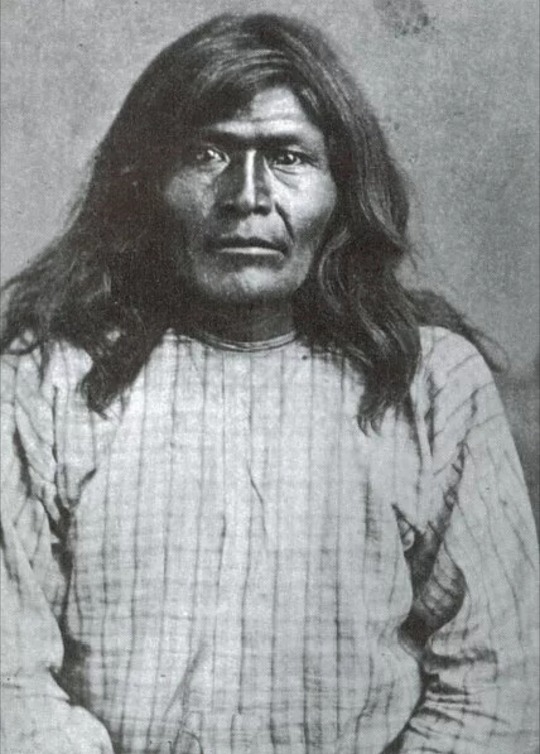
Victorio
Bidu-ya, more commonly known as Victorio, was a warrior and chief of the Warm Springs band of the Tchihendeh (or Chiricahua, often called Mimbreño) division of the central Apaches in what is now the American states of Texas, New Mexico, Arizona, and the Mexican states of Sonora and Chihuahua. Victorio was born in the Black Range of New Mexico in 1825. Victorio was raised as a member of the Eastern Chihenne Apache, also known as the Warm Springs and Mimbreno Apache. There is speculation that he or his band had Navajo kinship ties and was known among the Navajo as "he who checks his horse". Victorio's sister was the famous woman warrior Lozen; "Dextrous Horse Thief". In 1853 he was considered a chief or sub-chief by the United States Army and signed a document. In his twenties, he rode with Mangas Coloradas, leader of the Coppermine band of the Tchihendeh people and principal leader of the whole Tchihendeh Apache division (who took him as his son-in-law), and Cuchillo Negro, leader of the Warm Springs band of the Tchihendeh people and second principal leader of the whole Tchihendeh Apache division, as well as did Nana, Delgadito, Cochise, Juh, Geronimo and other Apache leaders. Mangas Coloradas taught Victorio how to create an ambush and to wait for enemies to enter the killing zone.[1] As was the custom, he became the leader of a large mixed band of Mimbreños and Mescaleros (led by his friend – and probably brother-in-law as husband of another daughter of Mangas Coloradas, as well Cochise) and fought against the United States Army. From 1870 to 1880, Victorio, chief of the Coppermine Mimbreños and principal leader of all the Tchihende, along with Loco, chief of the Warm Spring Mimbreños and second-ranking among the Tchihende, were moved to and left at least three different reservations, some more than once, despite their bands' request to live on traditional lands. Victorio, Loco and the Mimbreños were moved to San Carlos Reservation in Arizona Territory in 1877. Victorio and his followers (including old Nana) left the reservation twice, seeking and temporarily obtaining hospitality in Fort Stanton Reservation among their Sierra Blanca and Sacramento Mescalero allies and relatives (Caballero was probably Victorio's brother-in-law and Mangus' uncle, San Juan was too an old friend and Nana's wife was a Mescalero woman), before they came back to Ojo Caliente only to leave permanently in late August 1879, which started Victorio's War. Despite Nautzili's efforts, many Northern Mescalero warriors, led by Caballero and Muchacho Negro, joined him with their families, and San Juan and other Mescaleros also left their reservation; many Guadalupe and Limpia Mescalero too (Carnoviste and Alsate were close allies to Victorio after 1874) joined Victorio's people. Victorio was successful at raiding and evading capture by the military, and won a significant engagement at Las Animas Canyon in what is now the Aldo Leopold Wilderness on September 18 1879. In Victorio's War from September 1879 to October 1880, Victorio led a band of Apaches, never numbering more than 200 men, in a running battle with the U.S. and Mexican armies and the civilian population of New Mexico, Texas, and northern Mexico, fighting two dozen skirmishes and battles. In October 1880, in north-eastern Chihuahua (a land well-known to the Guadalupe and Limpia Southern Mescaleros), having sent Nana and Mangus to raid for food and ammunition, Victorio, with only a few warriors and even less ammunition, his band were surrounded and sadly, were murdered by soldiers of the Mexican Army under Colonel Joaquin.
#nativeamerican#apache#chiricahua#19thcentury#victorio#lozen#apachewars#battleofapachepass#trueamericans#warmspringsapache
2 notes
·
View notes
Text

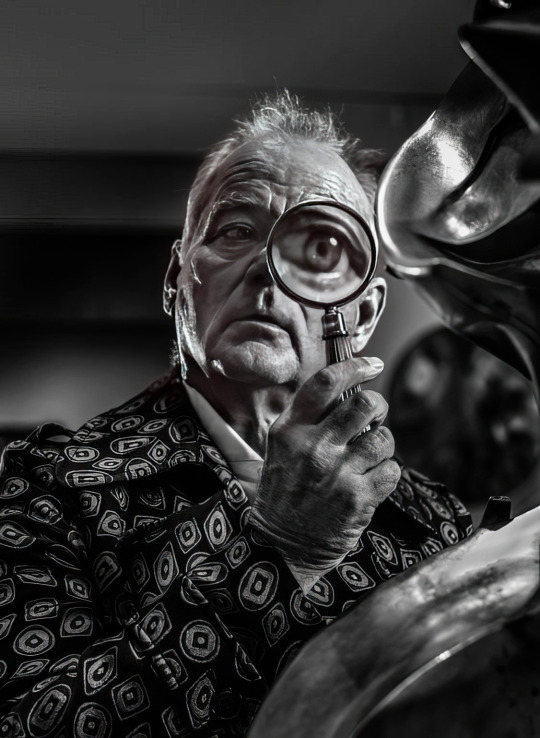
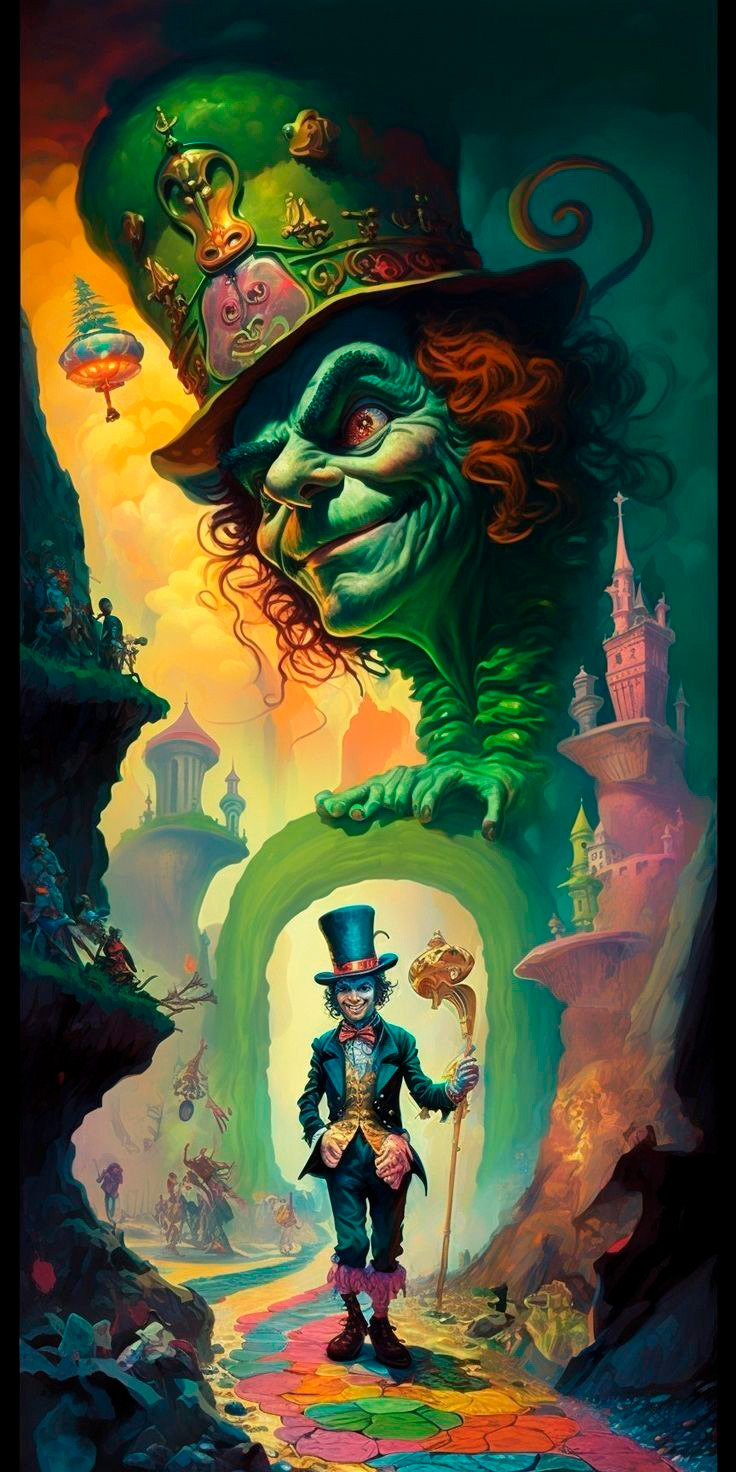

IMAGENES Y DATOS INTERESANTES DEL DIA 24 DE ABRIL DE 2024
Día internacional del Multilateralismo y la Diplomacia para la Paz, Día Internacional de Concienciación sobre el Ruido, Día Internacional del Perro Guía, Día Internacional del Animal de Laboratorio, Día Mundial sin ascensores, Día del Denim, Semana de Acción Mundial por la Educación, Semana Mundial de la Inmunización, Semana Europea de la Inmunización, Semana de Vacunación en las Américas, Año Internacional de los Camélidos.
Santa Bova y Santa Doda.
Tal día como hoy en el año 2003
En la revista científica Nature se anuncia la secuenciación completa del genoma humano, dos años antes de lo previsto. En mayo de 2006 se culminará el proyecto al publicarse la secuencia del último cromosoma humano en la misma revista. (Hace 21 años)
1990
En la bodega del transbordador espacial "Discovery", que se lanza hoy al espacio desde Cabo Cañaveral (EE.UU.), viaja el "Telescopio Espacial Hubble", proyecto conjunto de la NASA y la ESA. Mañana, lo dejarán en su órbita y, desde entonces este fabuloso observatorio astronómico, proporcionará datos e imágenes que revolucionarán el mundo de la astronomía, haciendo que los teóricos se replanteen algunas de sus ideas sobre la edad del universo. (Hace 34 años)
1953
En Reino Unido, Isabel II nombra "Caballero de la Jarretera" a Winston Churchill. Este mismo año la Academia Sueca le concederá el Premio Nobel de Literatura por su "descripción histórica y biográfica, así como por su brillante oratoria en defensa de los valores humanos". (Hace 71 años)
1916
En Dublín tienen lugar los "Levantamientos de Pascua" contra el gobierno británico, cuando nacionalistas irlandeses liderados por Patrick Pearse atacan las sedes de las delegaciones del gobierno de Dublín y sitian la oficina de correos. Al controlar la ciudad deciden proclamar la independencia de Irlanda. Al día siguiente, las autoridades británicas lanzarán una contraofensiva que se prolongará hasta el día 29, desbaratando por completo la sublevación. Pearse y otros 14 nacionalistas serán ejecutados por su participación en estos hechos. (Hace 108 años)
1898
España declara la guerra a los Estados Unidos tras conocer la orden de bloquear La Habana, dada por el presidente estadounidense McKinley a la flota americana. (Hace 126 años)
1854
En Viena (Austria) se celebra la fastuosa boda del emperador austríaco de 23 años Francisco José I y la princesa bávara Elizabeth, más conocida por Sissí, de igual edad. (Hace 170 años)
1834
En Perú tiene lugar el conocido como Abrazo de Maquinhuayo, que pone fin a la primera guerra civil de la historia republicana del Perú, cuando las tropas rebeldes de José Rufino Echenique se pasan a las del presidente Luis José de Orbegoso. (Hace 190 años)
1704
En Estados Unidos aparece el "Boston Letters", primer periódico de tirada continua de la norteamérica británica. (Hace 320 años)
1547
Tiene lugar la Batalla de Mühlberg, a orillas del Elba (Alemania), en la cual las tropas imperiales encabezadas por el emperador Carlos V (Carlos I de España), junto con algunos príncipes protestantes, vencen a los ejércitos de la Liga de Smalkalda mandados por Juan Federico y Felipe el Magnánimo, recuperando el control de Alemania. La batalla es fruto del proceso de luchas que tienen lugar durante la primera fase de la aplicación de la Reforma luterana en los territorios del Sacro Imperio Romano Germánico. (Hace 477 años)
1254
En San Juan de Acre, actual Israel, embarcan, derrotados y maltrechos de regreso a su patria, los contados supervivientes de la cruzada que seis años antes pusó en marcha Luis IX de Francia. (Hace 770 años)
1479aC
Sube al trono de Egipto, según la cronología de la XVIII dinastía, el faraón Tutmosis III. Siendo aún joven para gobernar, la reina Hatshepsut se hará cargo de la regencia hasta su muerte. A partir de entonces, Tutmosis III, será uno de los faraones más poderosos de Egipto y durante su mandato, su imperio alcanzará su mayor extensión territorial. Morirá en 1425 aC tras 54 años de reinado. (Hace 3503 años)
0 notes
Text
2024 Chicago Cubs Roster
Pitchers
#11 Todd Smyly; Jr. (Maumelle, Arkansas)
#18 Imanaga Shōta (Kitakyushu, Japan)**
#25 Yency Almonte (Miami, Florida)*
#26 Julian Merryweather (San Mateo, California)
#28 Kyle Hendricks (Mission Viejo, California)
#32 Ben Brown (Brookhaven, New York)**
#35 Justin Steele (George County, Mississippi)
#36 Jordan Wicks (Conway, Arkansas)
#38 Mark Leiter; Jr. (Toms River Township, New Jersey)
#43 Luke Little (Charlotte, North Carolina)
#45 Caleb Kilian (Flower Mound, Texas)
#48 Daniel Palencia (San Carlos, Venezuela)
#50 Jameson Taillon (Montgomery County, Texas)
#51 Héctor Neris (Villa Altagracia, Dominican Republic)*
#72 Javier Assad (Tijuana, Mexico)
#73 Adbert Alzolay (Ciudad Guayana, Venezuela)
Catchers
#9 Miguel Amaya (Chitré, Panama)
#15 Yan Gomes (Miami, Florida)
Infielders
#1 Nick Madrigal (Elk Grove, California)
#2 Nicholas Hoerner (Oakland, California)
#5 Christopher Morel (Santiago De Los Caballeros, Dom Rep)
#7 James Swanson (Kennesaw, Georgia)
#16 Patrick Wisdom (Murrieta, California)
#20 Miles Mastrobuoni (Livermore, California)
#29 Michael Busch (Inver Grove Heights, Minnesota)*
#41 Garrett Cooper (Rancho Palos Verdes, California)*
Outfielders
#8 Ian Happ (Mt. Lebanon, Pennsylvania)
#24 Cody Bellinger (Chandler, Arizona)
#27 Suzuki Seiya (Tokyo, Japan)
#40 Mike Tauchman (Palatine Township, Illinois)
Coaches
Manager Craig Counsell (Milwaukee Township, Wisconsin)
Bench coach Ryan Flaherty (Portland, Maine)
Hitting coach Dustin Kelly (Santa Maria, California)
Assistant hitting coach Juan Cabreja (Moca, Dominican Republic)
Assistant hitting coach Jim Adduci; Jr. (Worth Township, Illinois)
Assistant hitting coach John Mallee (Chicago, Illinois)
Pitching coach Tommy Hottovy (Kansas City, Missouri)
Assistant pitching coach Daniel Moskos (La Verne, California)
Pitching strategist Danny Hultzen (Montgomery County, Maryland)
Bullpen coach Darren Holmes (Asheville, North Carolina)
Bullpen catcher Garrett Lloyd (San Antonio, Texas)
1B coach Mike Napoli (Pembroke Pines, Florida)
3B coach Willie Harris (Cairo, Georgia)
Field coordinator Mark Strittmatter (Huntington, New York)
Assistant coach Jonathan Mota (Valencia, Venezuela)
Assistant coach Alex Smith (Scottsdale, Arizona)
#Sports#Baseball#MLB#Chicago Cubs#Celebrities#Mexico#New York#Japan#Arkansas#Florida#New Jersey#North Carolina#Dominican Republic#Venezuela#Mississippi#Texas#Panama#Minnesota#Georgia#Arizona#Pennsylvania#Illinois#Wisconsin#Maine#Missouri#Maryland
0 notes
Text
CERRAMOS LAS NOMINACIONES
Acá está la lista completa de latinos sexyman que fueron elegidos por repetición o sea, opinión popular y particularmente porque NO ME HICIERON DOLER LOS OJOS CUANDO LOS LEÍ DIOS SANTO ALGUIEN SUGIRIÓ A JENSEN ACKLES:
Juan Carlos Bodoque y Tulio Triviño (31 Minutos)
Don Ramón, El Chapulín Colorado y el Profesor Girafales (personajes asociados a Chespirito)
Black Hat y Dr Flung (Villanos)
José Carioca y Panchito Pistoles (Los tres Caballeros/Disney)
Reaper/Gabriel Reyes y Lucio (Overwatch)
Bruno (Encanto)
Gomez Addams (Los locos Addams)
Kronk y Pacha(Las locuras del Emperador)
EL CEPILLO COLGATE porque me mandaron 500 mensajes pidiendo que lo ponga
Mr. Trance (Mr. Trance)
Ravenna y Santos (Los Simuladores Argentina)
Manolo y Joaquin (El libro de la vida)
Carlitox (Alejo y Valentina)
Lobo/La muerte (Gato con Botas 2)
Speedy Gonzales (Loony Tunes)
Don Armando (Betty la fea)
Adrián Seidelman y Lucas Amato (Cyber Six)
Hector Rivera (Coco)
Condorito (Comics chilenos)
Isidoro Cañones (Comics argentinos)
Coco (Una película de huevos)
Rodolfo Rivera (El Tigre/Nickelodeon)
Carlos (WTNV)
El Locutor (La Frecuencia Kirlian)
Caesar Salazar (Rex)
Juandisimo (Los padrinos mágicos)
El Mandalorian (Star Wars)
El papá de Mafalda (Mafalda)
331 notes
·
View notes
Text
El Alcázar de Toledo en 1852


El Alcázar y el Puente de Alcántara
El puente de Alcántara se levanta donde el río Tajo se estrecha a su paso por Toledo en su parte oriental, a los pies del Castillo de San Servando y junto a la Puerta de Alcántara.
Es una construcción romana levantada en el siglo III d.C. que se convirtió en zona de paso por el que las calzadas romanas cruzaban el río y se adentraban en la ciudad.
Reconstruido en numerosas ocasiones, una de ellas se produjo en siglo X por Alef, hijo de Mohomat Alameri, en el año 997, según consta en una inscripción. Su nombre actual lo toma de esta época, del árabe "Alcántara" que significa puente.
Después, durante el resto del medievo, fue entrada obligada para todo peregrino, ejerciendo también la función de control de mercancias y de portazgo, labor ésta ejercida por el corregidor y alcalde de la ciudad.
Bajo el reinado de Alfonso X sufrió graves desperfectos y fue nuevamente reconstruido (siglo XIII). A este último período pertenece el torreón occidental, luego modificado y decorado bajo el reinado de los Reyes Católicos y cuyas armas decoran sus muros.
En un origen poseía dos torreones, situados en los extremos oriental y occidental del puente, y tres ojos, si bien uno de ellos fue tapiado en época islámica y sustituido por la apertura de un pequeño arco de herradura.
El torreón oriental fue reemplazado por un arco triunfal barroco en 1721, dado su estado ruinoso. El arco, construido en ladrillo y piedra, va recorrido por un orden gigante de pilastras y decorado por guirnaldas, rematado por un ático que se desarrolla a modo de frontón curvo decorado por una hornacina con la imagen de la Inmaculada Concepción.
A comienzo del siglo XX pertenecía a la casa ducal de Alba pero en 1911 fue expropiado por el Estado siendo declarado Monumento Nacional en 1921.
Detrás se levanta El Alcázar, fortificación sobre rocas, ubicada en la parte más alta de la ciudad de Toledo. Su nombre se debe a los árabes, que lo llamaron «Al Qasar», que significa «fortaleza».
Las investigaciones realizadas han atestiguado la existencia, a comienzos de nuestra era (época romana), de un recinto amurallado que partía desde una construcción de carácter defensivo, situado en la zona más alta de Toledo y seguía en línea recta hacia Zocodover y el Miradero, para unirse de nuevo a él a través del Puente de Alcántara.
Durante la Edad Media, en época visigoda, el rey Leovigildo (573-586 d.C.) estableció en Toledo su capitalidad y a partir de entonces se utilizaron las inmediaciones del Alcázar como «residencias regias». Después, en época musulmana, se convirtió en una fortaleza árabe (alcazaba), residencia del cadí, mandada construir por Abderramán III en 932 d.C y ya en la época de la Reconquista, en 1085, cuando Alfonso VI conquistó la ciudad, este monarca mandó construir un nuevo Alcázar sobre el ya existente. También Alfonso X el Sabio acometió obras de mejora en el edificio y durante el siglo XIV sirvió de hospedaje a Dª María de Padilla y a los caballeros toledanos fieles al rey D. Pedro, en su lucha contra D. Enrique de Trastámara.
En la Edad Moderna, cuando Carlos I regresó a España desde Alemania, el edificio fue modificado de nuevo en 1535 bajo su mandato, encargando las obras a los arquitectos Alonso de Covarrubias, Francisco de Villalpando y Juan de Herrera. Finalizaba así definitivamente, con esta remodelación, la vida de un edificio defensivo para convertirse en otro (conforme lo vemos hoy), hecho para residencia de reyes, sede de un gobierno nacional, para eje de un imperio, y sobre todo para mostrar el poder real incontestable de los Austrias.
Mucho años después, ya en Época Contemporánea, durante la Guerra Civil Española (1936), el Alcázar fue utilizado por el coronel José Moscardó como punto defensivo sufriendo grandes desperfectos. Su aspecto actual se debe a la reconstrucción que se produjo después de esa contienda.
Se trata de un palacio renacentista de grandes dimensiones, de planta rectangular de 60 mts. de lado, flanqueado en los ángulos por torres con chapiteles de forma cuadrada de 59 mts. de altura aproximadamente que sobresalen de los frentes y los superan en altura; todo él está labrado en piedra, excepto los entrepaños de la fachada sur, que son de ladrillo. En el interior posee un patio central con galerías con columnas con capiteles corintios, formando dos plantas, que descansan en arcos de medio punto.
El edificio del Alcázar es hoy sede del Gobierno Militar de Toledo, albergando una sección del Museo del Ejército y en su piso superior la Biblioteca Regional de Castilla-La Mancha.
Read the full article
1 note
·
View note
Text

VKM Reformas Ciudad Real
VKM Reformas está formado por un cluster de Estudios de Arquitectura, Interiorismo y Empresas de Reformas con equipos de Arquitectos, Interioristas y Reformistas profesionales en Rehabilitación y Reformas de Viviendas para Particulares en Ciudad Real
Visita nuestra web:
https://www.vkmreformasciudadreal.es
Ofrecemos servicios en:
Abenójar, Agudo Alamillo, Albaladejo, Alcázar de San Juan, Alcoba de los Montes, Alcolea Calatrava, Alcubillas, Aldea de Rey, Alhambra, Almadén, Almadenejos, Almagro, Almedina, Almodóvar del Campo, Almuradiel, Anchuras, Arenales de San Gregorio, Arenas de San Juan, Argamasilla de Alba, Argamasilla de Calatrava, Arroba de los Montes, Ballesteros de Calatrava, Bolaños de Calatrava, Brazatortas, Cabezarados, Cabezarrubias de Puerto, Calzada de Calatrava, Campo de Criptana, Cañada de Calatrava, Caracuel Calatrava, Carrión de Calatrava, Carrizosa, Castellar de Santiago, Chillón, Ciudad Real, Corral de Calatrava, Cózar, Daimiel, El Robledo, Fernán Caballero, Fontanarejo, Fuencaliente, Fuenllana, Fuente el Fresno, Granátula de Calatrava, Guadalmez, Herencia, Hinojosas de Calatrava, Horcajo de los Montes, La Solana, Las Labores, Llanos del Caudillo, Los Cortijos, Los Pozuelos de Calatrava, Luciana, Malagón, Manzanares, Membrilla, Mestanza, Miguelturra, Montiel, Moral de Calatrava, Navalpino, Navas de Estena, Pedro Muñoz, Picón, Piedrabuena, Poblete, Porzuna, Pozuelo de Calatrava, Puebla de Don Rodrigo, Puebla del Príncipe, Puerto Lápice, Puertollano, Retuerta del Bullaque, Ruidera, Saceruela, San Carlos del Valle, San Lorenzo de Calatrava, Santa Cruz de los Cáñamos, Santa Cruz de Mudela, Socuéllamos, Solana del Pino, Terrinches, Tomelloso, Torralba de Calatrava, Torre de Juan Abad, Torrenueva, Valdemanco de Esteras, Valdepeñas, Valenzuela de Calatrava, Villahermosa, Villamanrique, Villamayor de Calatrava, Villanueva de la Fuente, Villanueva de los Infantes, Villanueva de San Carlos, Villar del Pozo, Villarrubia de los Ojos, Villarta de San Juan, Viso del Marqués.
0 notes